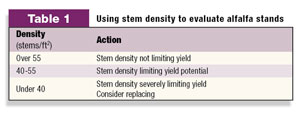This needs to be prior to a hard freeze that kills the plants and stops root reserve accumulation. Several Midwestern studies have shown that alfalfa cut in mid-September actually incurs the greatest yield reduction the following spring, by approximately 0.6 tons per acre.
Whereas, alfalfa left uncut after late summer, or not cut again until after going dormant, exhibits little winter injury and yields well accordingly.
Lessen the potential negative impact of a fall harvest by either cutting early enough in the fall to ensure adequate regrowth or waiting until after two consecutive days of a hard freeze (24 to 26ºF). For all fall cuttings, leave at least 4 inches of stubble to help catch insulating snows.
Fall alfalfa fertilization
Get a lab analysis done on your soils so you know what you have compared to what you need. Research shows successful alfalfa winter survival is linked to the level of potassium (K) fertilization. Potassium has a positive effect on nodulation and nitrogen fixation. When soil test K is high and the alfalfa plant is healthy, stand persistence typically is very high. In contrast, fields with very low soil potassium levels often result in significant winter injury and stands decline.
Each ton of dry matter hay removes about 50 pounds of K (60 pounds K2O) and about 15 pounds of P2O5. To avoid “luxury consumption,” a split application, based on yield goals, is recommended after first cutting and again in late summer. If making a single annual application, doing so in early fall will help minimize the potential for winter injury.
Soil pH
Proper pH (6.8 to 7.0) is absolutely critical for establishing and maintaining high-quality alfalfa stands. Liming to adjust pH also sustains more activity of nitrogen-fixing rhizobium bacteria, adds calcium and magnesium, improves soil structure and tilth, and increases the availability of phosphorus and molybdenum. Lime effectiveness is determined by its chemical purity and the fineness to which it is ground.
Keep the stand or plow it under?
Fall is a very good time to assess whether or not to keep a field of alfalfa for another year. And both the stand and any weed issues can be effectively taken out with a fall application of herbicide. If the field has been destroyed in the fall, the field will be easier to plow, or if going into reduced- or no-till, more easily planted.
Corn is a great crop to plant after alfalfa because of the significant levels of nitrogen (N), with research studies showing up to 100 pounds of N available. Rotating out of alfalfa also breaks disease and insect cycles. However, growers considering plowing alfalfa down after first cutting then planting corn, need to consider the yield tradeoffs – the loss of the corn crop due to delayed planting versus a realistic first-cutting yield of the alfalfa harvest from a thin stand.
To determine the yield potential of an alfalfa stand, use an equation developed by the University of Wisconsin:
Yield (tons/acre) =
(Stems/ft2 x 0.1) + 0.38
 Use the guidelines in Table 1 to aid in making a decision about keeping a stand.
Use the guidelines in Table 1 to aid in making a decision about keeping a stand.
If your stand is at 40 to 55 stems per square foot and shows signs of injury (slow, uneven growth), increase cutting height and allow alfalfa plants to mature to nearly full flower in the first cut, and early flowering in subsequent harvests. Obviously, these late harvests will cause lower feed quality. But this practice stabilizes the health of the stand and should be balanced with the need of keeping the stand productive enough to retain for the year. FG
—Excerpts from Pioneer Hi-Bred Forage Byte newsletter, August 2009









